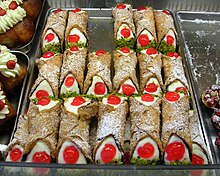Cannoli
 Cannoli topped with chopped pistachios, candied fruit and chocolate chips sprinkled with confectioner's sugar | |
| Type | Pastry |
|---|---|
| Place of origin | Italy |
| Region or state | Sicily |
| Main ingredients | fried pastry dough, ricotta filling |
| Variations | Kannoli (Malta) Kanojët (Albania) |

Cannoli (Italian: [kanˈnɔːli]; Sicilian: cannola [kanˈnɔːla]) are Italian pastries consisting of tube-shaped shells of fried pastry dough, filled with a sweet, creamy filling usually containing ricotta—a staple of Sicilian cuisine.[1][2] They range in size from 9 to 20 centimetres (3+1⁄2 to 8 in). In mainland Italy, they are commonly known as cannoli siciliani (Sicilian cannoli).
Etymology[]
In English, cannoli is usually used as a singular, but in Italian, it is grammatically plural; the corresponding singular is cannolo (Italian: [kanˈnɔːlo]; Sicilian: cannolu [kanˈnɔːlʊ]), a diminutive meaning 'little tube', from canna, 'cane' or 'tube'.[3] This form is uncommon in English.[3]
History[]
Some food historians place the origins of cannoli in 827–1091 AD in Caltanissetta, by the concubines of princes looking to capture their attention.[4]
Author Gaetano Basile merged this legend with other historical traditions to determine[5] that cannoli come from the Palermo and Messina[6] areas and were historically prepared as a treat during Carnival season, possibly as a fertility symbol.[7] The dessert eventually became a year-round staple in Sicily.
Some similar desserts in Middle Eastern tradition include "Zaynab's fingers" (أصابع زينب), which are filled with nuts,[8] and qanawāt (قنوات), deep-fried dough tubes filled with various sweets, which were a popular pastry across the ancient Islamic world. The dish and the name may originate from the Muslim Emirate of Sicily.[9] The minne di Sant'Agata or minni di virgini, cheese filled half spheres with icing and fruit are shaped like a breast in honour of St Agatha. Feddi dû cancillieri ("chancellor's slices") are similar cream and apricot jam filled almond cookies designed to look like the rear of a person.[10]
See also[]
- Ricotta
- Hyblean ricotta
References[]
- ^ Gangi, Robert (2006). "Cannoli". bestofsicily.com. Retrieved 15 May 2014.
- ^ "The Cannoli of Piana degli Albanesi". A Taste of Travel. Retrieved 15 October 2014.
- ^ a b "Cannoli". Oxford English Dictionary (3rd ed.). Oxford University Press. 2003. (Subscription or participating institution membership required.)
- ^ "History of Sicilian Cannoli. A Sweet Mystery". JustSicily. 14 November 2017. Retrieved 14 January 2021.
- ^ "The "spicy" history of cannoli Siciliani". Life in Italy. 30 September 2019. Retrieved 14 January 2021.
- ^ "30 cannoli siciliani perfetti per un tentativo di classifica definitiva". Scatti di Gusto (in Italian). 22 July 2014. Retrieved 15 October 2014.
- ^ "The Cannoli and It's [sic] Rich History | Cannoli Kitchen". 26 March 2019. Archived from the original on 25 January 2021. Retrieved 14 January 2021.
- ^ Michael Krondl (2011). Sweet Invention: A History of Dessert. Chicago Review Press. p. 102. ISBN 9781556529542.
- ^ Paul H. Freedman (2007). Food: The History of Taste (illustrated ed.). University of California Press. p. 159. ISBN 9780520254763.
- ^ Petroni, Agostino. "The erotic origins of Italy's most famous sweet". www.bbc.com. Retrieved 14 January 2021.
External links[]
- Italian pastries
- Cuisine of Sicily
- Italian desserts
- Maltese cuisine
- Albanian cuisine
- Stuffed desserts
- Cheese desserts